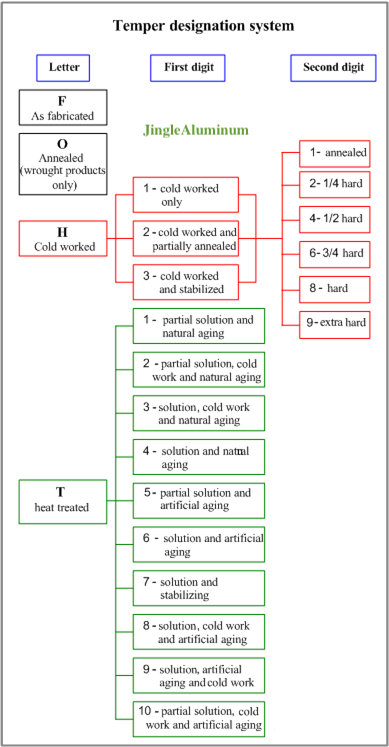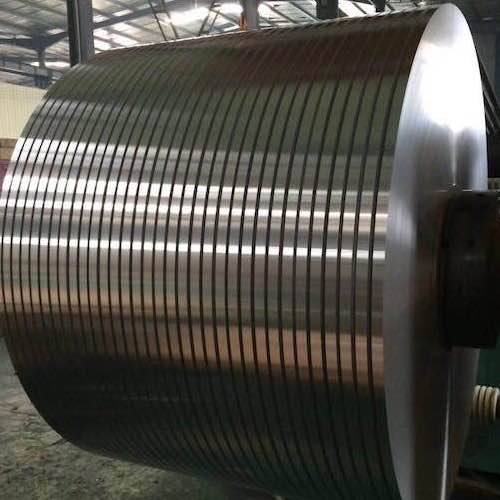Basic Aluminum Temper Designations

The temper designation appears as a hyphenated suffix to the basic alloy number. An example would be 7075-T73 is the temper designation. Four basic temper designations are ued for Aluminum Alloys. They are - F: as fabricated; -O: annealed; -H: strain hardened and -T: thermally treated. A fifth designation, -W, is used to describe an asquenched conditon between solution heat treatment and artificial or room temperature aging. Following is a list of tempers which define aluminum alloys.
-H111: Applies to products which are strain-hardened less than the amount required for a controlled H11 temper.
-H112: Applies to products which acquire some temper from shaping processes not having special control over the amount of strain-hardening or thermal treatment, but for which there are mechanical property limits.
The following H temper designations have been assigned for wrount products in alloys containing over a nominal 4 percent magnesium.
-H311: Applies to products which are stain-hardened less than the amount for a controllled H31 temper.
-H321: Applies to products which are strain-hardened less than the amount for a controlled H32 temper.
-H323: Applies to products which are specially fabricated to have acceptable resistance to stress corosion cracking.
Products which are thermally treeted with or without supplementary strain-hardening are designated with a -T temper. The T is followed by a digit or digits wich designate the specific thermal treatment. Temper designations for aluminum alloys are as follows:
-Tl: Cooled from an elevated temperature shaping process and naturally aged to a substantially stable conditons.
-T2: Annealed (cast products only)
-T3: Solutions heat treated and then cold worked. Applies to products which are cold worked to improve strength or in which the effect of cold work in flattening or straightening is recognized in mechanical property limits.
-T31: Solutions heat treated and then cold worked by flattening or stretching. Applies to 2219 and 2024 sheet and plate per MIL-A-8920. Also applies to rivets driven cold immediatedly afteer solution heat treatment or clod storage. 2024 rivets are an example.
-T351: Solutions heat treatment and stress relieved by stretching. This is equivalent to T4 conditions. It applies to 2024 plate and rolled bar and 2219 plate per MIL-A-8920.
-T3511: Solution heat treated and stress relieved by stretching with minor stretching allowed. This is equiivalent to -T4 conditions and applies to 2024 extrusions.
-T37: Solutions heat treated and then cold worked by a reduction of 8 percent. Applies to 2219 sheet and plate.
-T4: Solution heat treated and naturally ages to a substantially stable condition. Applies to products which are not cold worked after solution heat treatment, or in which the effect of cold work in flattening or straightening may not be recognized in mechanical property limits.
-T42: Solution heat treated and naturally aged by the user to a substantialy stable condition. Applies to 2014-0 and 2024-0 plate and extrusions which are heat treated by the user from the anneealed condition.
-T451: Solution heat treated and stress relieved by stretching, Equivalent to -T4 and applies to plate and rolled bar stock except 2024 and 2219.
-T4511: Solutions heat treated and stress relieved by stretching with minor straightening allowed. Equivalent to -T4 and applies to all extrusions except 2024 and 2219.
-T5: Cooled from an elevated temperature shaping process and then artificially aged.
-T51: Cooled from an elevated temperature shaping process, stress-relieved by stretching and then artificially aged.
-T52: Cooled from an elevated temperature shaping process, stress-relieved by compressing and then artifically aged.
-T54: Cooled from an elevated temperature shaping process, stress-relived by stretching and compressing and then artificially aged. Applies to die forgings which are stress-relieved by restriking cold in the finish die.
-T6: Solution heat treated and then artificially aged. Mechanical property limits not affected by cold working. Most alloys in the -w and -T4 conditions artificially aged to -T6.
-T61: Solution heat treated and then artificially aged. Applies to forgings which receive a boiling water quench to avoid internal quenching stress. Applies to solution heat treated and artificially aged castings when more than one aging cycle is available for that alloy.
-T611: Solution heat treated and artificially aged. Applies only to 7079 forgings which are quenched in 1750 to 185°F water.
-T62: Solution heat treated and then artificially aged by the user. Applies to any temper which has been heat treated and aged by user which attains mechanical prperties different from those of -T6 conditons.
-T651: Solutions heat treated, stess-relieved by stretching and artificially aged. Equivalent to -T6 and applies to plate and rolled bar except 2219.
-T6510: Solution heat treated, stress-relieved by stretching and artificially aged with no hard straightening after aging. Applies to extruded rod, bar and shape except 2024.
-T6511: Solution heat treated, stress-relieved by stretching and artificially aged with minor straightening. Equivalent to -T6 and applies to extruded rod, bar and shape except 2024.
-T652: Solution heat treated, stress-relieved by compressive deformation and artificially aged. Equivalent to -T6 and applies to hard forged squares, rectangles and simply shaped die forgings except 2219.
-T7: Solution heat treated and then stabilized. Applies to products which are stabilized to carry them beyond the point of maximum strength to provide control of growth and residual stress.
-T73: Solution heat treated and then specially arftificially aged. Applies to 7075 alloys whih have been specially aged to make the material resistant to stress-corrosion.
-T8: Solution heat treated, cold worked and then artificially aged. Applies to products which are cold worked to improve strenth, or in which the effect of cold work in flattening or straightening is recognized in the mechanical property limits.
-T81: Solution heat treated, cold worked and then artificially aged. Applies to 2024-T3 artificially aged to T81.
-T851: Solution heat treated, stress-relieved by stretching and artificially aged. Appliccalbe to plate, rolled bar and rod.
-T86: Solution heat treated, cold workd by a thickness reduction of 6 percent and then artificially aged. Applies to 2024 sheet and plate.
-T87: Solution heat treated, cold worked by a thickness reduction of 10 percent and then artificially aged. Applies to 2219 sheet and plate.
-T9: Solution heat treated, artificially aged and then cold worked. Applies to products which are cold worked to improve strength.
-T10: Cooled from an elevated temperature shaping process, artificially aged and then cold worked. Applies to products which are artificially aged after cooling from an elevated temperature shaping process, such as casting or extrusion and then cold worked to further improve strength.
Therefore, choosing the suitable aluminum temper, it is so important for material applicaton and production, if you do not know which is suitable, and maybe we can give you some suggestion.
JingAluminum is the professional manufacturer for alumnium coil, sheet, foil, strip, circle, with color or plain, and with 10 years experience for exporting, and your trust is so important and it can make our business easier. Thank you for ur time and support. felipe.zhao@aluminumcoil.net
